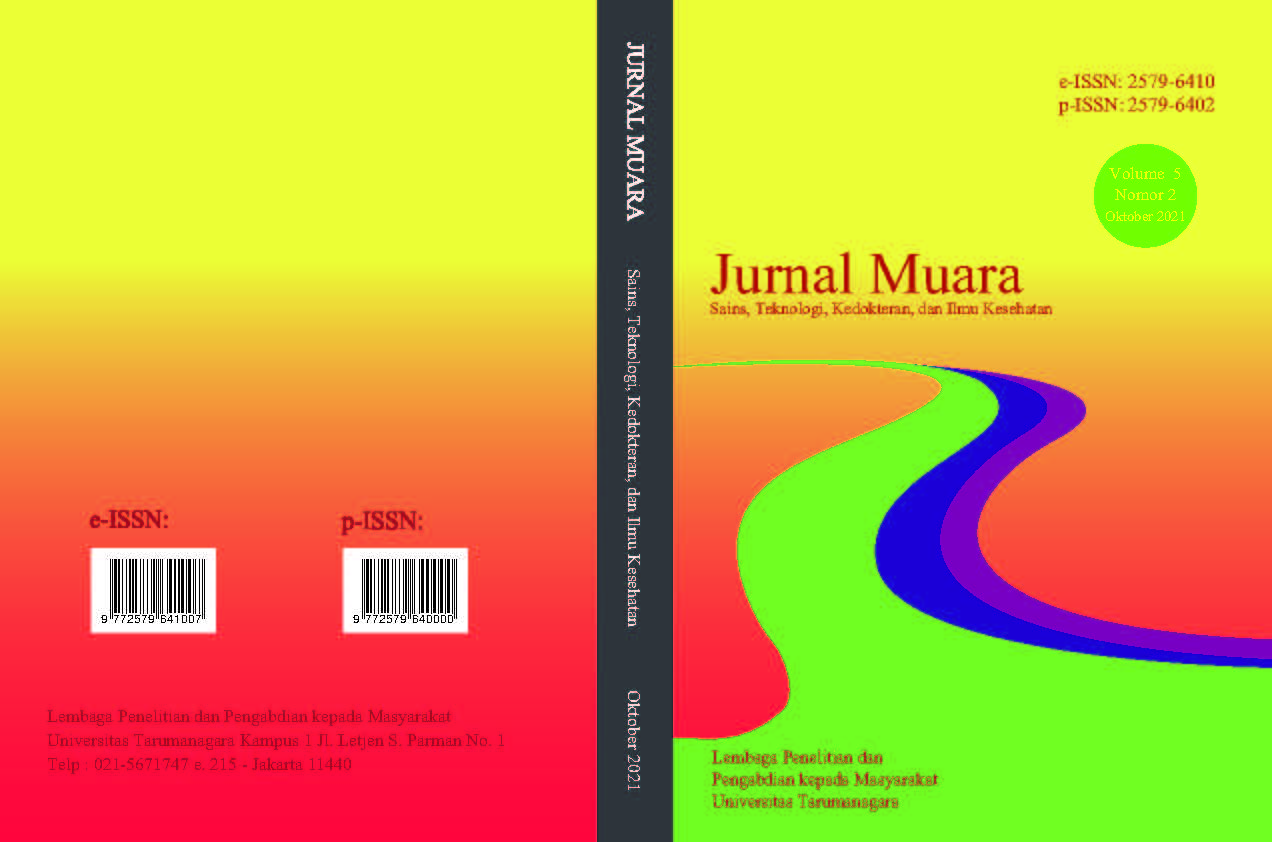ANALISIS DOSIS RADIASI PADA JARINGAN TUMOR DENGAN SIMULASI PROGRAM MCNP-5
Main Article Content
Abstract
Direct measurement of each radiation dose to the patient's organs is not possible. In general, to estimate the dose absorbed by human organs is approached by measurements in human phantoms, but this approach is still too rough because the composition of phantoms is not easily made the same as the actual organ composition. Currently, for important matters such as the accuracy of determining the absorption dose by human organs, the Monte Carlo simulation method (MCNP) with special software is used. This has led to a growing desire for scientists to make the transition from using phantoms to computing software for medical physics applications. However, until now no comprehensive document has been written to introduce the use of the MCNP program to simulate its application in medical physics. The purpose of this study was to analyze the absorbed dose of gamma radiation in tumor tissue in the breast by simulating changes in distance and tumor size using the MCNP-5 program. This can be useful in ensuring the application of radiation protection to the patient and the environment in which the patient is located. The results showed that the radiation dose in cell 1 (tumor tissue) with a change in the distance between the radiation source and cell 1 was getting bigger, resulting in a decrease in the dose in cell 1, while the effect of cell volume 1 was greater, the greater the dose received by cell 1. In addition, through this simulation it can be seen that for each addition of 1 cm3 the volume of cell 1 for tumor tissue can increase the absorption energy by 3.5x10e-12 Gray.
Keywords: MCNP-5; simulation; radiation dose; tumor tissue
Abstrak
Pengukuran setiap dosis radiasi pada organ pasien tidak dimungkinkan secara langsung. Pada umumnya untuk memperkirakan dosis yang diserap oleh organ tubuh manusia didekati dengan pengukuran pada phantom manusia, namun pendekatan ini juga masih terlalu kasar karena komposisi phantom tidak mudah dibuat sama dengan komposisi organ yang sebenarnya. Sehingga saat ini, untuk hal-hal yang penting seperti ketepatan penentuan dosis serap oleh organ tubuh manusia, digunakan metode simulasi Monte Carlo (MCNP) dengan perangkat lunak khusus. Hal ini mendorong meningkatnya keinginan para ilmuwan melakukan transisi dari penggunaan phantom ke penggunaan komputasi perangkat lunak untuk aplikasi fisika medis. Namun sampai saat ini belum tersedia dokumen komprehensif yang ditulis untuk memperkenalkan penggunaan program MCNP guna mensimulasikan aplikasinya dalam fisika medis. Tujuan penelitian ini adalah menganalisis dosis serap radiasi gamma pada jaringan tumor di payudara melalui simulasi perubahan jarak dan besar tumor menggunakan program MCNP-5. Hal ini dapat berguna dalam memastikan penerapan proteksi radiasi pada pasien dan lingkungan tempat pasien. Hasil penelitian menunjukkan dosis radiasi pada sel 1 (jaringan tumor) dengan perubahan jarak antara sumber radiasi dengan sel 1 semakin besar, mengakibatkan besar dosis di sel 1 semakin menurun, sedangkan pengaruh volume sel 1 yang semakin besar maka dosis yang diterima sel 1 semakin besar juga. Selain itu, melalui simulasi ini dapat diketahui untuk setiap penambahan 1 cm3 volume sel 1 jaringan tumor dapat meningkatkan energi serap sebesar 3,5x10e-12 Gray.
Article Details
This work is licensed under a Jurnal Muara Sains, Teknologi, Kedokteran dan Ilmu Kesehatan Creative Commons Attribution-ShareAlike 4.0 International License.
Authors transfer copyright or assign exclusive rights to the publisher (including commercial rights)
References
Aznar, M. C., Medin, J., Hemdal, B., Thilander Klang, A., Bøtter-Jensen, L., Mattsson, S. (2005). A Monte Carlo study of the energi dependence of al2o3:c crystals for real-time in vivo dosimetry in mammography. Radiation Protection Dosimetry. 114(1-3), 444–449. doi:10.1093/rpd/nch560
Bor D., Tukel S., Olgar T., Aydin E., (2008). Variations in breast doses for an automatic mammography unit. Diagn. Interv. Radiol. 14:122-126.
Dance, D.R. (1990). Monte Carlo calculation of conversion factors for the estimation of mean glandular breast dose. Phys. Med. Biol., 35(9), 1211-1219.
Diffey, J., Cartwright, L., Crocker, J., Heggie, J. (2014). Direct half value layer measurements in mammography-is near enough good enough? Combined Scientific Meeting. DOI:10.1594/ranzcr2014/R-0127
Douglas, E. P., Kuruvilla, V. (2000). Digital mammography image simulation using Monte Carlo. Medical Physics, 27(568). doi: 10.1118/1.598896
Koutalonis, M., Delis, H., Spyrou, G., Costaridou, L., Tzanakos, G., Panayiotakis, G. (2007). Contrast-to-noise ratio in magnification mammography: a Monte Carlostudy. Phys. Med. Biol. 52. 3185–3199. doi:10.1088/0031-9155/52/11/017
Olgar, T, Kahn, T., Gosch, D. (2012). Average Glandular Dose in Digital Mammography and Breast Tomosynthesis. Fortschr. Röntgenstr. 184, 911–918. DOI: 10.1055/s-0032-1312877.
Pandiangan, T., Bali, I., Silalahi, A.R.J. (2019). Early lung cancer detection using artificial neural network. Atom Indonesia, 45(1), 9-15. https://doi.org/10.17146/aij.2019.860
Pandiangan, T., Bali, I., Silalahi, A. (2020). The use of MNCP-5 particle transport program for calculation of flux radiation exposure in object surface. IOP Conf. Ser.: Mater. Sci. Eng., 852, 012174. https://doi.org/10.1088/1757-899X/852/1/012174
Ramos, M.A.P., Ferrer, S., Verdu, G., Padovani, E., Campayo, J.M. (2004). A mammographic phantom image reconstruction through Monte Carlo techniques. Nuclear Science Symposium Conference Record, IEEE, 5. DOI: 10.1109/NSSMIC.2004.1466322
Sechopoulos, I., Suryanarayanan, S., Vedantham, S., D'Orsi, C.J., Karellas, A. (2007). Computation of the glandular radiation dose in digital tomosynthesis of the breast. Med Phys. 34(1), 221–232. doi: 10.1118/1.2400836
Sechopoulos, I., Suryanarayanan, S., Vedantham, S., D'Orsi, C.J., Karellas, A. (2008). Radiation dose to organs and tissues from mammography: Monte Carlo and phantom study”. Radiology, 246(2), 434-443. DOI: 10.1148/radiol.2462070256
Skowronek J. (2017). Current status of brachytherapy in cancer treatment - short overview. J Contemp Brachytherapy, 9(6):581–589. doi:10.5114/jcb.2017.72607
Skowronek J, Chiche? A. (2014). Brachytherapy in breast cancer: an effective alternative. Prz Menopauzalny, 13(1):48–55. doi:10.5114/pm.2014.41090


